Strategic Management Analysis: Telstra Corporation, University Report
VerifiedAdded on 2022/08/20
|29
|8692
|15
Report
AI Summary
This report provides a comprehensive analysis of strategic management within Telstra Corporation Limited, a prominent telecommunications company in Australia. It begins with an introduction to strategic management, defining its core principles and importance. The report then delves into a brief description of Telstra, its services, and its significance in the Australian market. A critical literature review explores key theories of strategy, including strategy formulation, Chamberlain's theory, and the relationship between strategy, innovation, and change. The discussion section critically analyzes Telstra's strategic processes, assesses employee engagement with strategies, and offers recommendations for improvement. The analysis includes the definition of strategy, strategy formulation, and the working principles of a business strategy. The report examines the role of resources, core competencies, and scope in organizational strategy. Finally, the report concludes with a summary of the findings and recommendations for enhancing Telstra's strategic management practices. The student assignment is a critical essay of 6000 words integrating theory and practice.
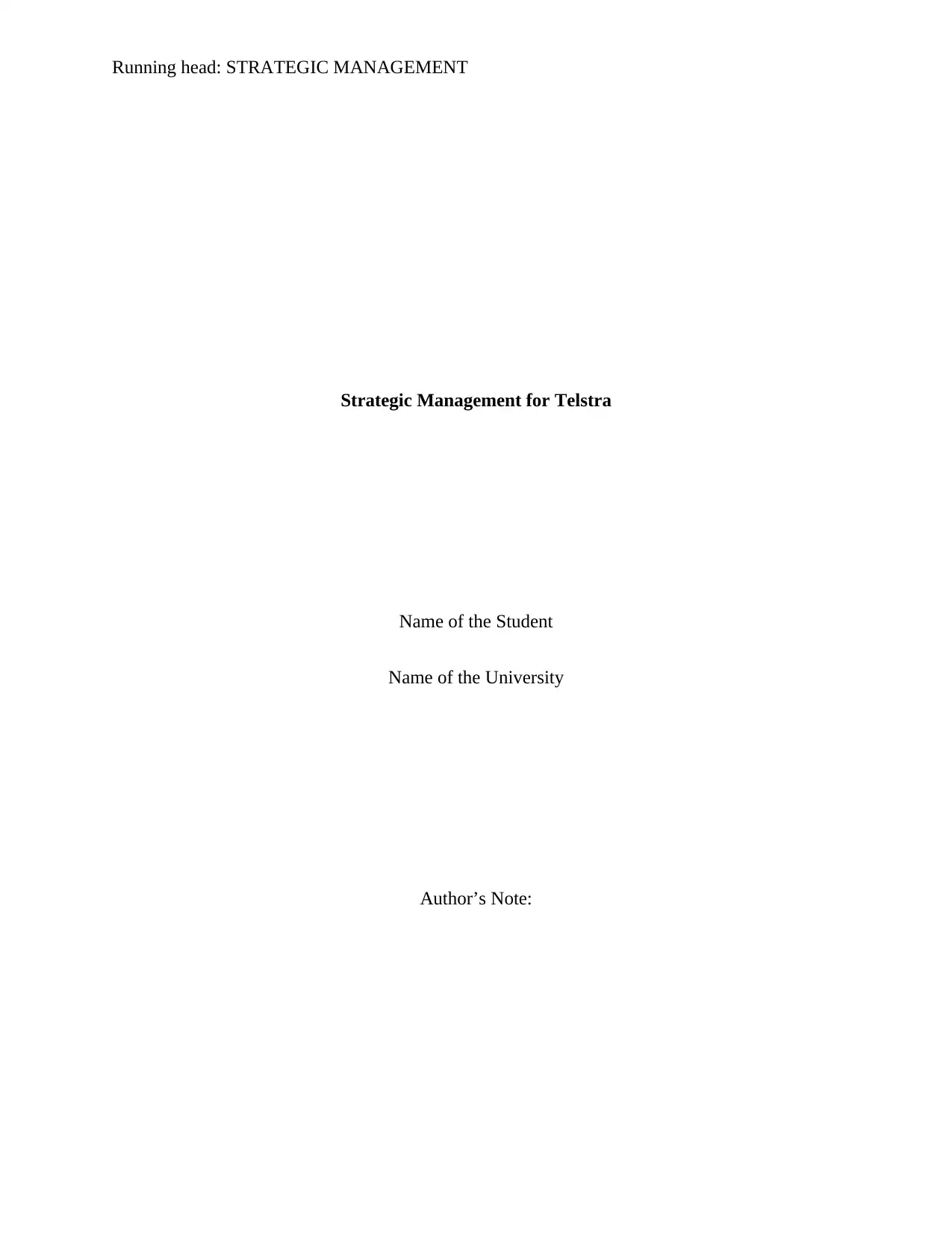
Running head: STRATEGIC MANAGEMENT
Strategic Management for Telstra
Name of the Student
Name of the University
Author’s Note:
Strategic Management for Telstra
Name of the Student
Name of the University
Author’s Note:
Paraphrase This Document
Need a fresh take? Get an instant paraphrase of this document with our AI Paraphraser
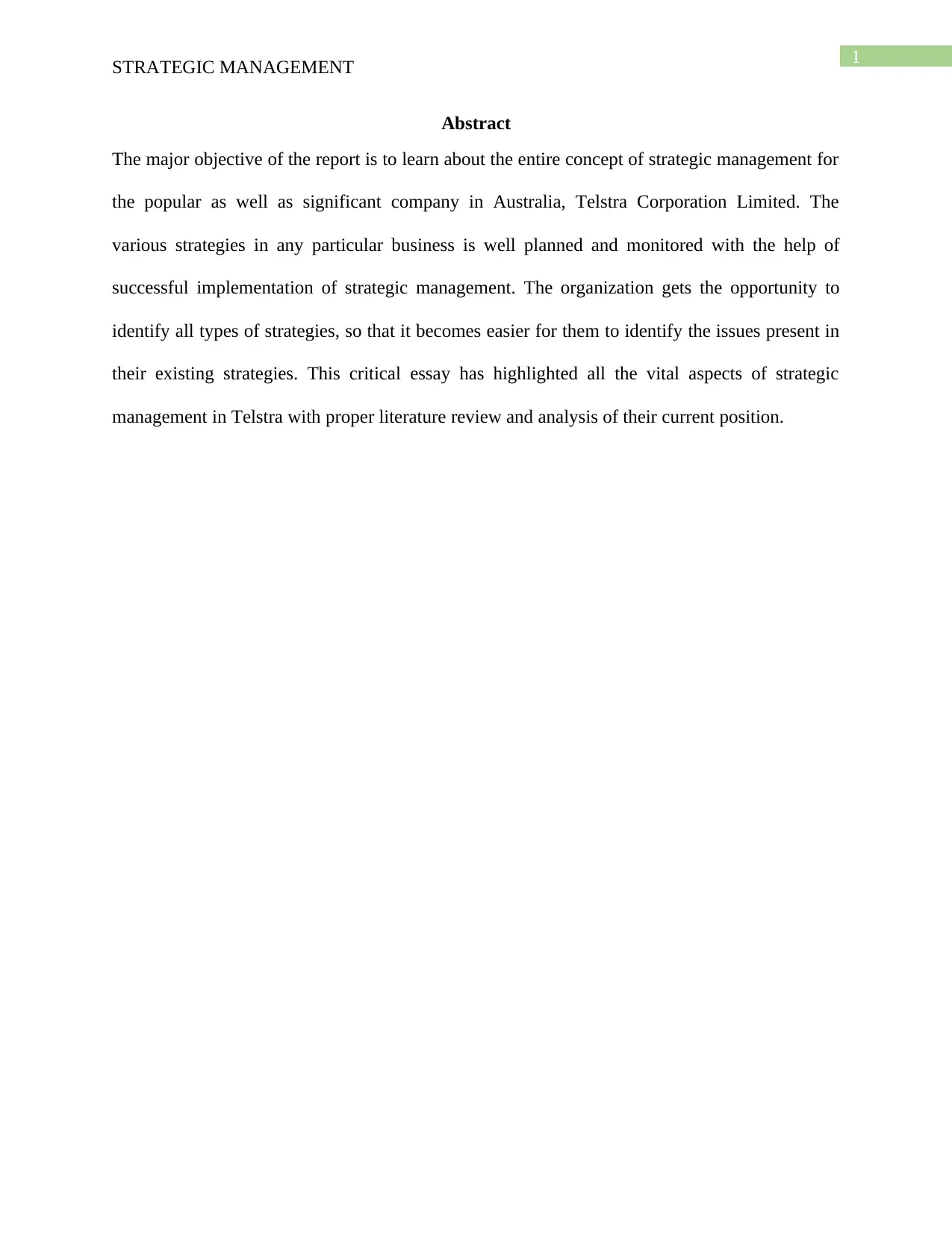
1
STRATEGIC MANAGEMENT
Abstract
The major objective of the report is to learn about the entire concept of strategic management for
the popular as well as significant company in Australia, Telstra Corporation Limited. The
various strategies in any particular business is well planned and monitored with the help of
successful implementation of strategic management. The organization gets the opportunity to
identify all types of strategies, so that it becomes easier for them to identify the issues present in
their existing strategies. This critical essay has highlighted all the vital aspects of strategic
management in Telstra with proper literature review and analysis of their current position.
STRATEGIC MANAGEMENT
Abstract
The major objective of the report is to learn about the entire concept of strategic management for
the popular as well as significant company in Australia, Telstra Corporation Limited. The
various strategies in any particular business is well planned and monitored with the help of
successful implementation of strategic management. The organization gets the opportunity to
identify all types of strategies, so that it becomes easier for them to identify the issues present in
their existing strategies. This critical essay has highlighted all the vital aspects of strategic
management in Telstra with proper literature review and analysis of their current position.
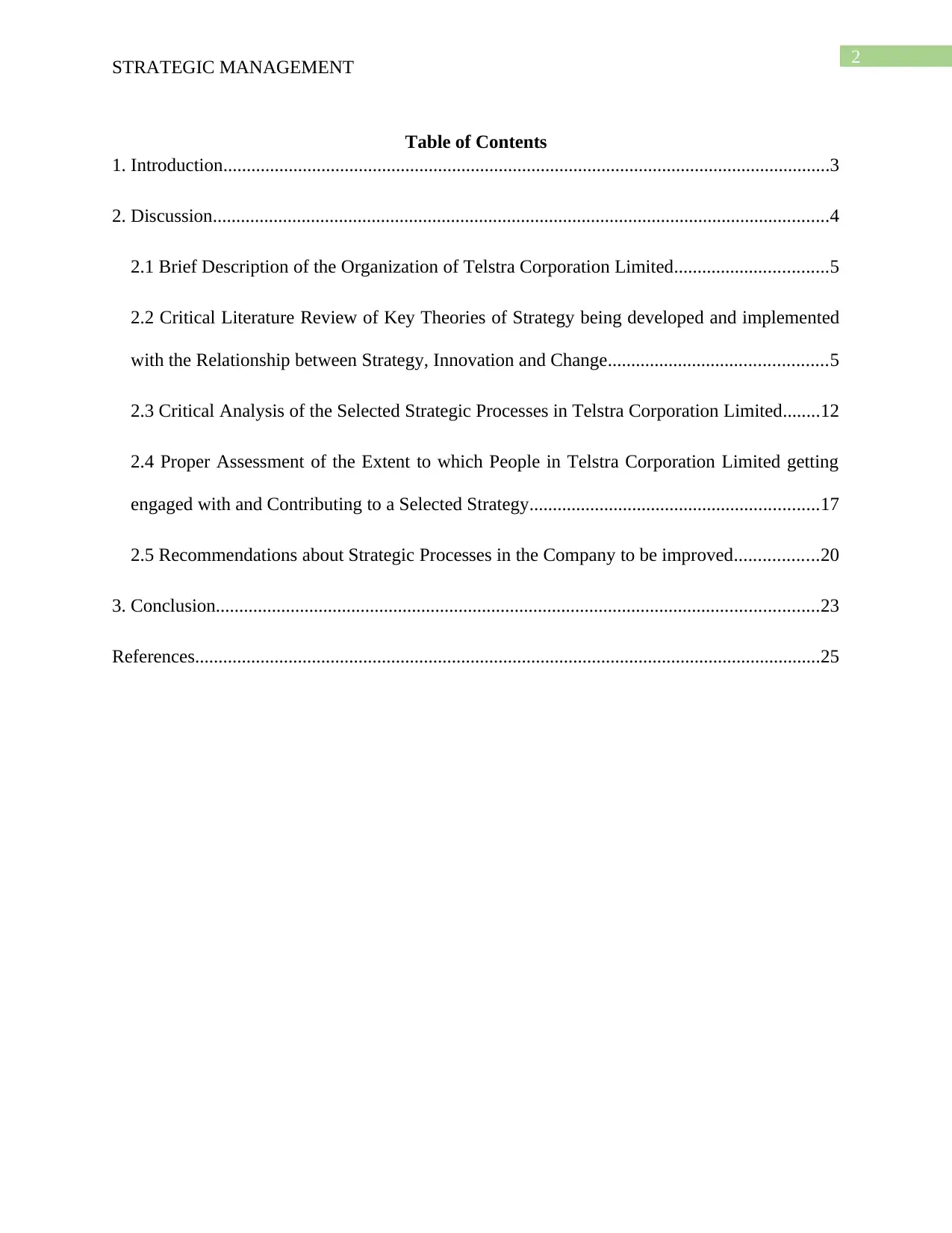
2
STRATEGIC MANAGEMENT
Table of Contents
1. Introduction..................................................................................................................................3
2. Discussion....................................................................................................................................4
2.1 Brief Description of the Organization of Telstra Corporation Limited.................................5
2.2 Critical Literature Review of Key Theories of Strategy being developed and implemented
with the Relationship between Strategy, Innovation and Change...............................................5
2.3 Critical Analysis of the Selected Strategic Processes in Telstra Corporation Limited........12
2.4 Proper Assessment of the Extent to which People in Telstra Corporation Limited getting
engaged with and Contributing to a Selected Strategy..............................................................17
2.5 Recommendations about Strategic Processes in the Company to be improved..................20
3. Conclusion.................................................................................................................................23
References......................................................................................................................................25
STRATEGIC MANAGEMENT
Table of Contents
1. Introduction..................................................................................................................................3
2. Discussion....................................................................................................................................4
2.1 Brief Description of the Organization of Telstra Corporation Limited.................................5
2.2 Critical Literature Review of Key Theories of Strategy being developed and implemented
with the Relationship between Strategy, Innovation and Change...............................................5
2.3 Critical Analysis of the Selected Strategic Processes in Telstra Corporation Limited........12
2.4 Proper Assessment of the Extent to which People in Telstra Corporation Limited getting
engaged with and Contributing to a Selected Strategy..............................................................17
2.5 Recommendations about Strategic Processes in the Company to be improved..................20
3. Conclusion.................................................................................................................................23
References......................................................................................................................................25
⊘ This is a preview!⊘
Do you want full access?
Subscribe today to unlock all pages.

Trusted by 1+ million students worldwide
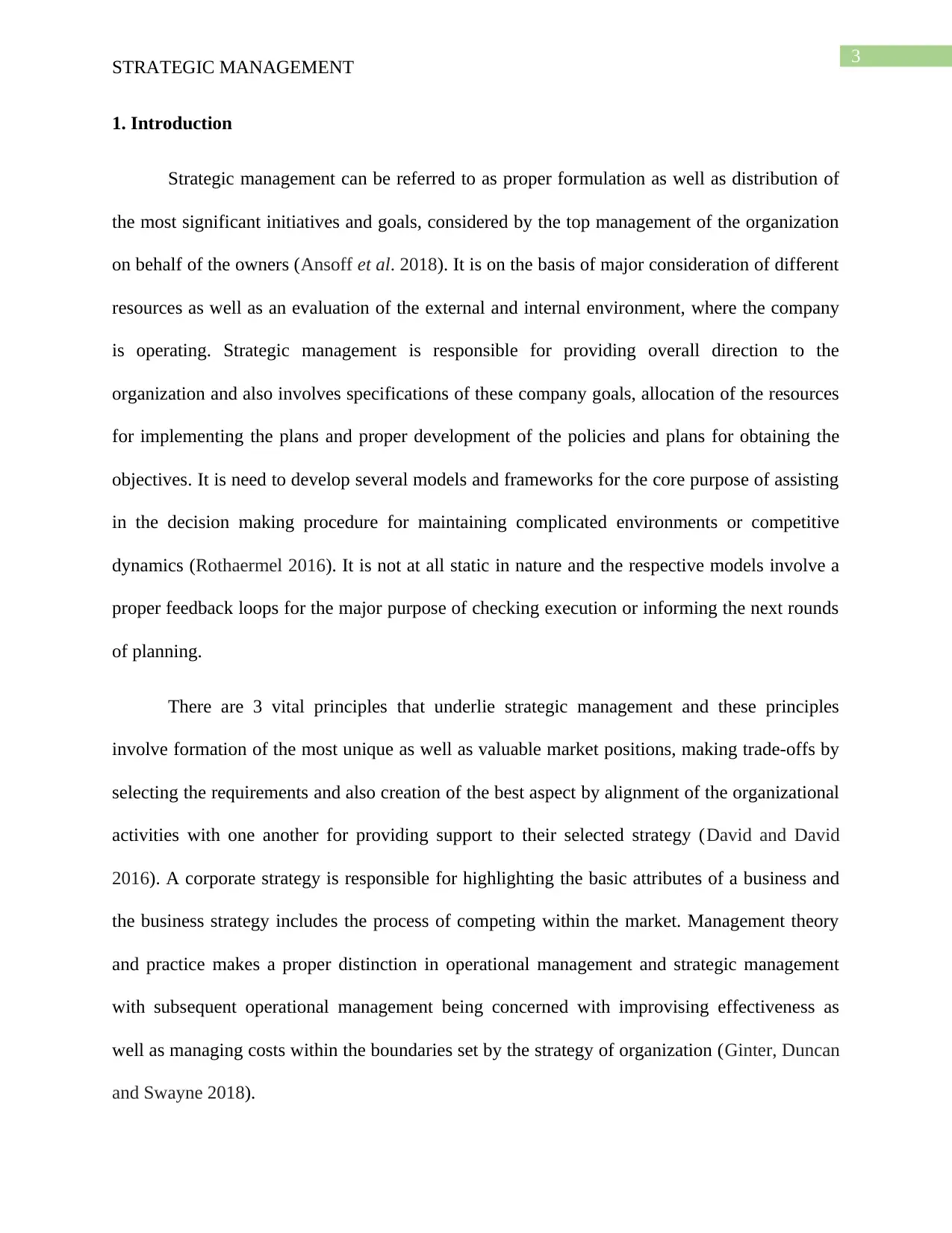
3
STRATEGIC MANAGEMENT
1. Introduction
Strategic management can be referred to as proper formulation as well as distribution of
the most significant initiatives and goals, considered by the top management of the organization
on behalf of the owners (Ansoff et al. 2018). It is on the basis of major consideration of different
resources as well as an evaluation of the external and internal environment, where the company
is operating. Strategic management is responsible for providing overall direction to the
organization and also involves specifications of these company goals, allocation of the resources
for implementing the plans and proper development of the policies and plans for obtaining the
objectives. It is need to develop several models and frameworks for the core purpose of assisting
in the decision making procedure for maintaining complicated environments or competitive
dynamics (Rothaermel 2016). It is not at all static in nature and the respective models involve a
proper feedback loops for the major purpose of checking execution or informing the next rounds
of planning.
There are 3 vital principles that underlie strategic management and these principles
involve formation of the most unique as well as valuable market positions, making trade-offs by
selecting the requirements and also creation of the best aspect by alignment of the organizational
activities with one another for providing support to their selected strategy (David and David
2016). A corporate strategy is responsible for highlighting the basic attributes of a business and
the business strategy includes the process of competing within the market. Management theory
and practice makes a proper distinction in operational management and strategic management
with subsequent operational management being concerned with improvising effectiveness as
well as managing costs within the boundaries set by the strategy of organization (Ginter, Duncan
and Swayne 2018).
STRATEGIC MANAGEMENT
1. Introduction
Strategic management can be referred to as proper formulation as well as distribution of
the most significant initiatives and goals, considered by the top management of the organization
on behalf of the owners (Ansoff et al. 2018). It is on the basis of major consideration of different
resources as well as an evaluation of the external and internal environment, where the company
is operating. Strategic management is responsible for providing overall direction to the
organization and also involves specifications of these company goals, allocation of the resources
for implementing the plans and proper development of the policies and plans for obtaining the
objectives. It is need to develop several models and frameworks for the core purpose of assisting
in the decision making procedure for maintaining complicated environments or competitive
dynamics (Rothaermel 2016). It is not at all static in nature and the respective models involve a
proper feedback loops for the major purpose of checking execution or informing the next rounds
of planning.
There are 3 vital principles that underlie strategic management and these principles
involve formation of the most unique as well as valuable market positions, making trade-offs by
selecting the requirements and also creation of the best aspect by alignment of the organizational
activities with one another for providing support to their selected strategy (David and David
2016). A corporate strategy is responsible for highlighting the basic attributes of a business and
the business strategy includes the process of competing within the market. Management theory
and practice makes a proper distinction in operational management and strategic management
with subsequent operational management being concerned with improvising effectiveness as
well as managing costs within the boundaries set by the strategy of organization (Ginter, Duncan
and Swayne 2018).
Paraphrase This Document
Need a fresh take? Get an instant paraphrase of this document with our AI Paraphraser
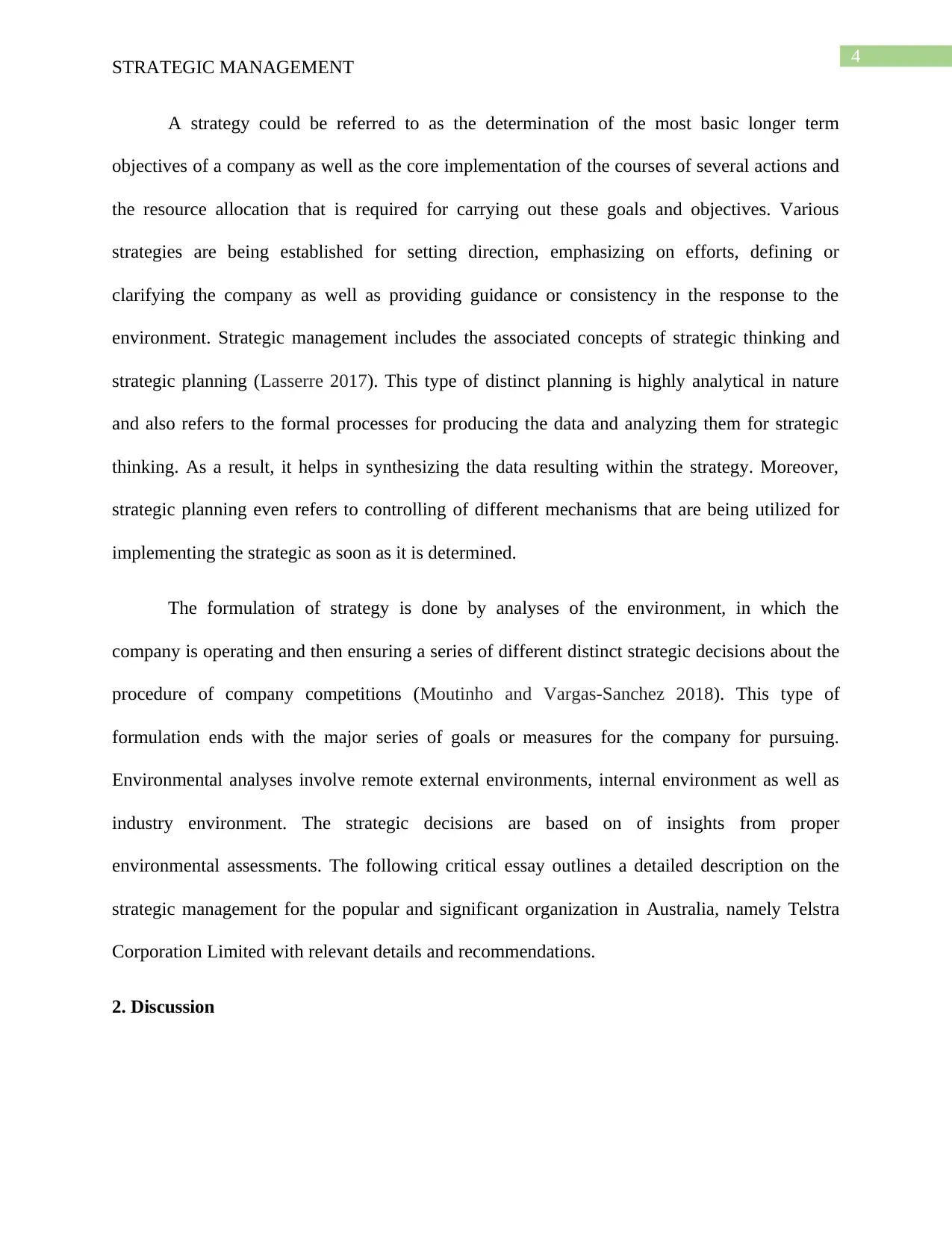
4
STRATEGIC MANAGEMENT
A strategy could be referred to as the determination of the most basic longer term
objectives of a company as well as the core implementation of the courses of several actions and
the resource allocation that is required for carrying out these goals and objectives. Various
strategies are being established for setting direction, emphasizing on efforts, defining or
clarifying the company as well as providing guidance or consistency in the response to the
environment. Strategic management includes the associated concepts of strategic thinking and
strategic planning (Lasserre 2017). This type of distinct planning is highly analytical in nature
and also refers to the formal processes for producing the data and analyzing them for strategic
thinking. As a result, it helps in synthesizing the data resulting within the strategy. Moreover,
strategic planning even refers to controlling of different mechanisms that are being utilized for
implementing the strategic as soon as it is determined.
The formulation of strategy is done by analyses of the environment, in which the
company is operating and then ensuring a series of different distinct strategic decisions about the
procedure of company competitions (Moutinho and Vargas-Sanchez 2018). This type of
formulation ends with the major series of goals or measures for the company for pursuing.
Environmental analyses involve remote external environments, internal environment as well as
industry environment. The strategic decisions are based on of insights from proper
environmental assessments. The following critical essay outlines a detailed description on the
strategic management for the popular and significant organization in Australia, namely Telstra
Corporation Limited with relevant details and recommendations.
2. Discussion
STRATEGIC MANAGEMENT
A strategy could be referred to as the determination of the most basic longer term
objectives of a company as well as the core implementation of the courses of several actions and
the resource allocation that is required for carrying out these goals and objectives. Various
strategies are being established for setting direction, emphasizing on efforts, defining or
clarifying the company as well as providing guidance or consistency in the response to the
environment. Strategic management includes the associated concepts of strategic thinking and
strategic planning (Lasserre 2017). This type of distinct planning is highly analytical in nature
and also refers to the formal processes for producing the data and analyzing them for strategic
thinking. As a result, it helps in synthesizing the data resulting within the strategy. Moreover,
strategic planning even refers to controlling of different mechanisms that are being utilized for
implementing the strategic as soon as it is determined.
The formulation of strategy is done by analyses of the environment, in which the
company is operating and then ensuring a series of different distinct strategic decisions about the
procedure of company competitions (Moutinho and Vargas-Sanchez 2018). This type of
formulation ends with the major series of goals or measures for the company for pursuing.
Environmental analyses involve remote external environments, internal environment as well as
industry environment. The strategic decisions are based on of insights from proper
environmental assessments. The following critical essay outlines a detailed description on the
strategic management for the popular and significant organization in Australia, namely Telstra
Corporation Limited with relevant details and recommendations.
2. Discussion
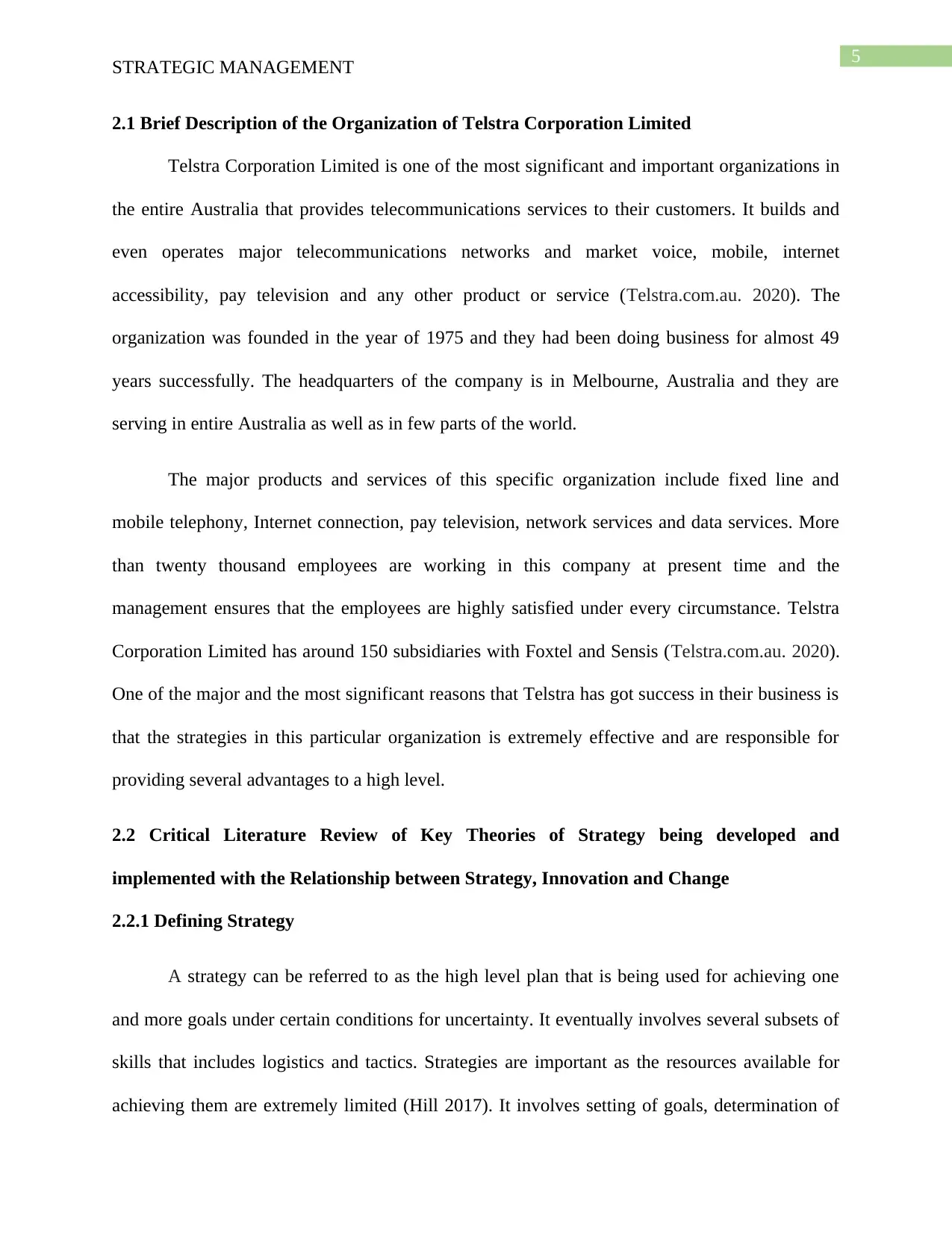
5
STRATEGIC MANAGEMENT
2.1 Brief Description of the Organization of Telstra Corporation Limited
Telstra Corporation Limited is one of the most significant and important organizations in
the entire Australia that provides telecommunications services to their customers. It builds and
even operates major telecommunications networks and market voice, mobile, internet
accessibility, pay television and any other product or service (Telstra.com.au. 2020). The
organization was founded in the year of 1975 and they had been doing business for almost 49
years successfully. The headquarters of the company is in Melbourne, Australia and they are
serving in entire Australia as well as in few parts of the world.
The major products and services of this specific organization include fixed line and
mobile telephony, Internet connection, pay television, network services and data services. More
than twenty thousand employees are working in this company at present time and the
management ensures that the employees are highly satisfied under every circumstance. Telstra
Corporation Limited has around 150 subsidiaries with Foxtel and Sensis (Telstra.com.au. 2020).
One of the major and the most significant reasons that Telstra has got success in their business is
that the strategies in this particular organization is extremely effective and are responsible for
providing several advantages to a high level.
2.2 Critical Literature Review of Key Theories of Strategy being developed and
implemented with the Relationship between Strategy, Innovation and Change
2.2.1 Defining Strategy
A strategy can be referred to as the high level plan that is being used for achieving one
and more goals under certain conditions for uncertainty. It eventually involves several subsets of
skills that includes logistics and tactics. Strategies are important as the resources available for
achieving them are extremely limited (Hill 2017). It involves setting of goals, determination of
STRATEGIC MANAGEMENT
2.1 Brief Description of the Organization of Telstra Corporation Limited
Telstra Corporation Limited is one of the most significant and important organizations in
the entire Australia that provides telecommunications services to their customers. It builds and
even operates major telecommunications networks and market voice, mobile, internet
accessibility, pay television and any other product or service (Telstra.com.au. 2020). The
organization was founded in the year of 1975 and they had been doing business for almost 49
years successfully. The headquarters of the company is in Melbourne, Australia and they are
serving in entire Australia as well as in few parts of the world.
The major products and services of this specific organization include fixed line and
mobile telephony, Internet connection, pay television, network services and data services. More
than twenty thousand employees are working in this company at present time and the
management ensures that the employees are highly satisfied under every circumstance. Telstra
Corporation Limited has around 150 subsidiaries with Foxtel and Sensis (Telstra.com.au. 2020).
One of the major and the most significant reasons that Telstra has got success in their business is
that the strategies in this particular organization is extremely effective and are responsible for
providing several advantages to a high level.
2.2 Critical Literature Review of Key Theories of Strategy being developed and
implemented with the Relationship between Strategy, Innovation and Change
2.2.1 Defining Strategy
A strategy can be referred to as the high level plan that is being used for achieving one
and more goals under certain conditions for uncertainty. It eventually involves several subsets of
skills that includes logistics and tactics. Strategies are important as the resources available for
achieving them are extremely limited (Hill 2017). It involves setting of goals, determination of
⊘ This is a preview!⊘
Do you want full access?
Subscribe today to unlock all pages.

Trusted by 1+ million students worldwide
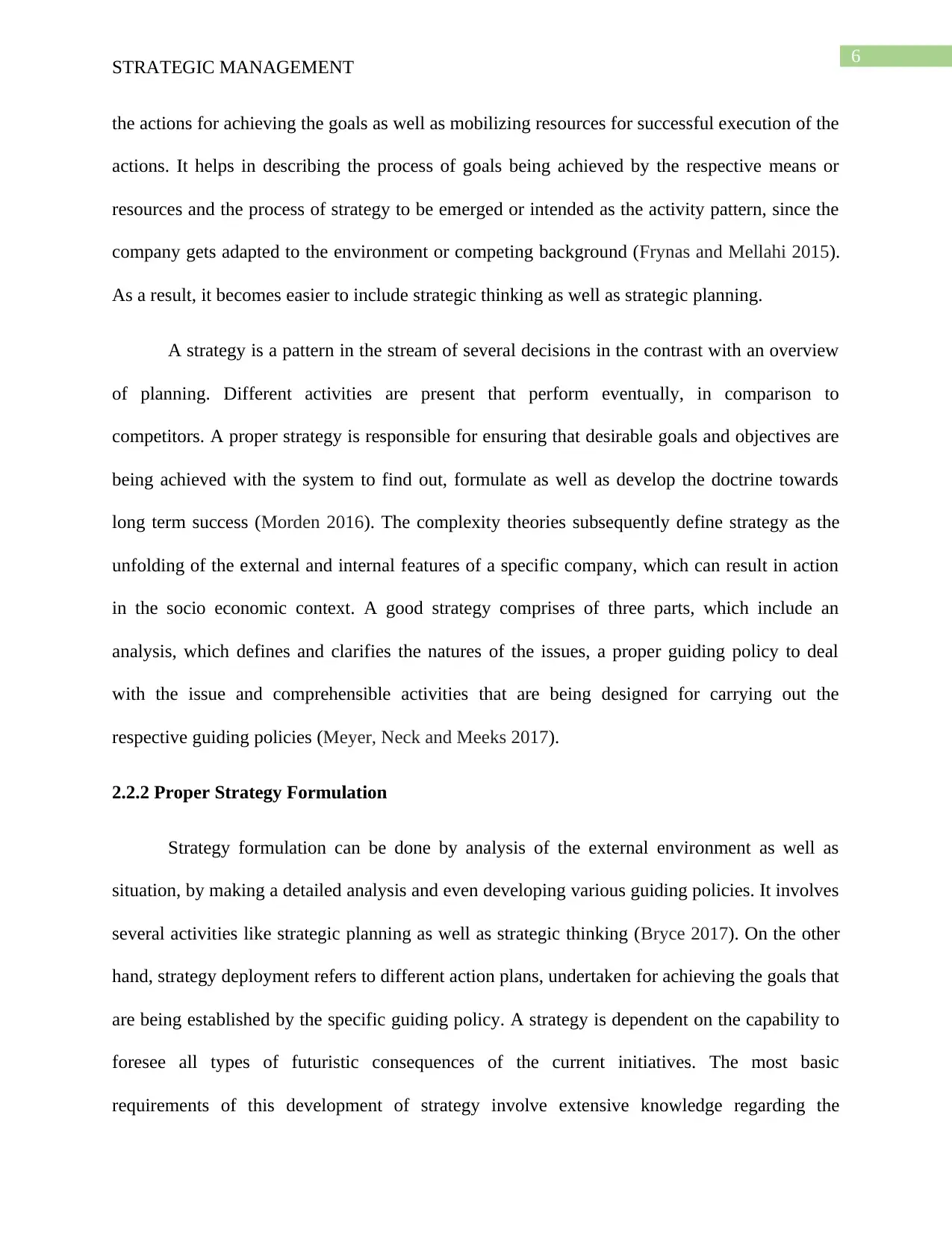
6
STRATEGIC MANAGEMENT
the actions for achieving the goals as well as mobilizing resources for successful execution of the
actions. It helps in describing the process of goals being achieved by the respective means or
resources and the process of strategy to be emerged or intended as the activity pattern, since the
company gets adapted to the environment or competing background (Frynas and Mellahi 2015).
As a result, it becomes easier to include strategic thinking as well as strategic planning.
A strategy is a pattern in the stream of several decisions in the contrast with an overview
of planning. Different activities are present that perform eventually, in comparison to
competitors. A proper strategy is responsible for ensuring that desirable goals and objectives are
being achieved with the system to find out, formulate as well as develop the doctrine towards
long term success (Morden 2016). The complexity theories subsequently define strategy as the
unfolding of the external and internal features of a specific company, which can result in action
in the socio economic context. A good strategy comprises of three parts, which include an
analysis, which defines and clarifies the natures of the issues, a proper guiding policy to deal
with the issue and comprehensible activities that are being designed for carrying out the
respective guiding policies (Meyer, Neck and Meeks 2017).
2.2.2 Proper Strategy Formulation
Strategy formulation can be done by analysis of the external environment as well as
situation, by making a detailed analysis and even developing various guiding policies. It involves
several activities like strategic planning as well as strategic thinking (Bryce 2017). On the other
hand, strategy deployment refers to different action plans, undertaken for achieving the goals that
are being established by the specific guiding policy. A strategy is dependent on the capability to
foresee all types of futuristic consequences of the current initiatives. The most basic
requirements of this development of strategy involve extensive knowledge regarding the
STRATEGIC MANAGEMENT
the actions for achieving the goals as well as mobilizing resources for successful execution of the
actions. It helps in describing the process of goals being achieved by the respective means or
resources and the process of strategy to be emerged or intended as the activity pattern, since the
company gets adapted to the environment or competing background (Frynas and Mellahi 2015).
As a result, it becomes easier to include strategic thinking as well as strategic planning.
A strategy is a pattern in the stream of several decisions in the contrast with an overview
of planning. Different activities are present that perform eventually, in comparison to
competitors. A proper strategy is responsible for ensuring that desirable goals and objectives are
being achieved with the system to find out, formulate as well as develop the doctrine towards
long term success (Morden 2016). The complexity theories subsequently define strategy as the
unfolding of the external and internal features of a specific company, which can result in action
in the socio economic context. A good strategy comprises of three parts, which include an
analysis, which defines and clarifies the natures of the issues, a proper guiding policy to deal
with the issue and comprehensible activities that are being designed for carrying out the
respective guiding policies (Meyer, Neck and Meeks 2017).
2.2.2 Proper Strategy Formulation
Strategy formulation can be done by analysis of the external environment as well as
situation, by making a detailed analysis and even developing various guiding policies. It involves
several activities like strategic planning as well as strategic thinking (Bryce 2017). On the other
hand, strategy deployment refers to different action plans, undertaken for achieving the goals that
are being established by the specific guiding policy. A strategy is dependent on the capability to
foresee all types of futuristic consequences of the current initiatives. The most basic
requirements of this development of strategy involve extensive knowledge regarding the
Paraphrase This Document
Need a fresh take? Get an instant paraphrase of this document with our AI Paraphraser
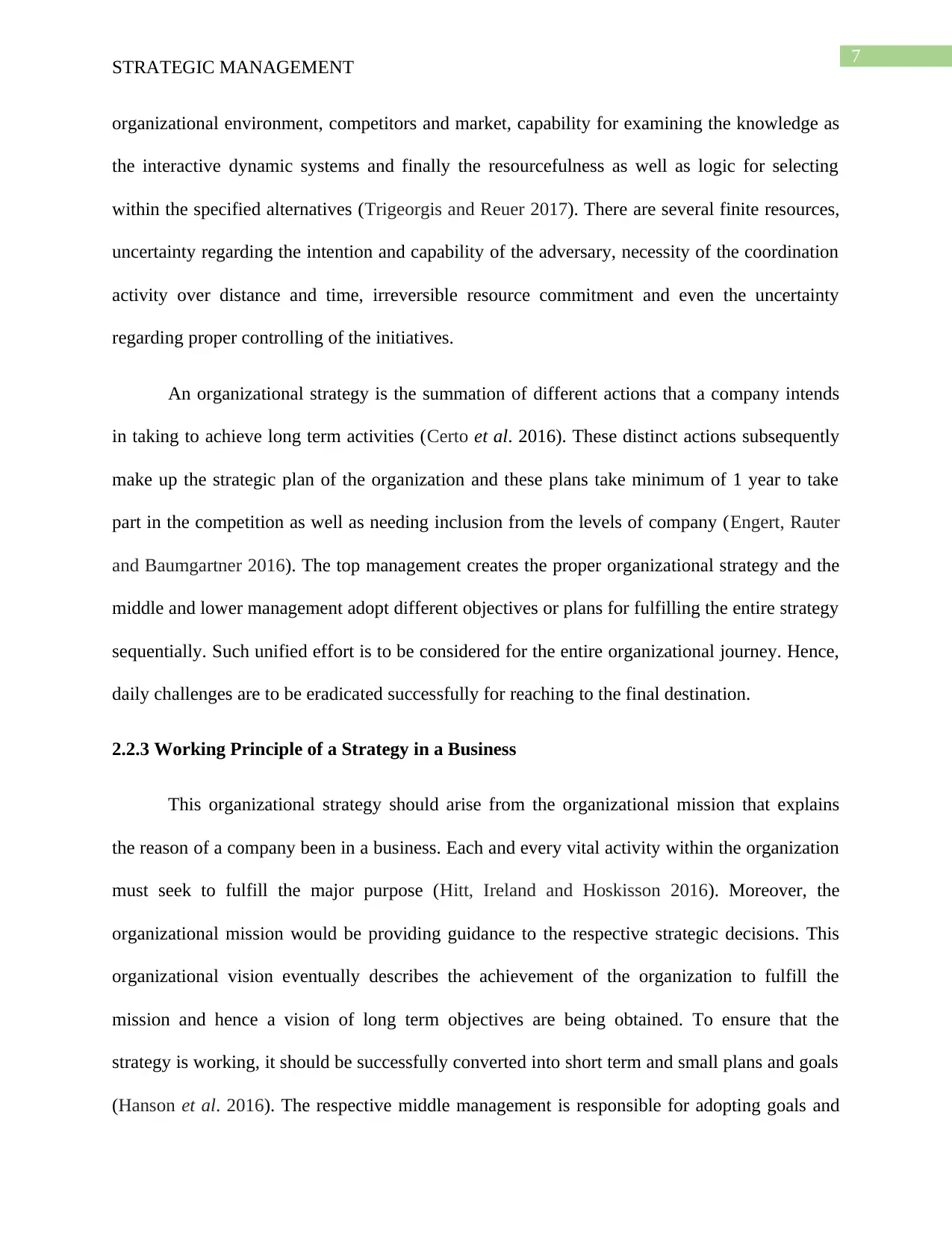
7
STRATEGIC MANAGEMENT
organizational environment, competitors and market, capability for examining the knowledge as
the interactive dynamic systems and finally the resourcefulness as well as logic for selecting
within the specified alternatives (Trigeorgis and Reuer 2017). There are several finite resources,
uncertainty regarding the intention and capability of the adversary, necessity of the coordination
activity over distance and time, irreversible resource commitment and even the uncertainty
regarding proper controlling of the initiatives.
An organizational strategy is the summation of different actions that a company intends
in taking to achieve long term activities (Certo et al. 2016). These distinct actions subsequently
make up the strategic plan of the organization and these plans take minimum of 1 year to take
part in the competition as well as needing inclusion from the levels of company (Engert, Rauter
and Baumgartner 2016). The top management creates the proper organizational strategy and the
middle and lower management adopt different objectives or plans for fulfilling the entire strategy
sequentially. Such unified effort is to be considered for the entire organizational journey. Hence,
daily challenges are to be eradicated successfully for reaching to the final destination.
2.2.3 Working Principle of a Strategy in a Business
This organizational strategy should arise from the organizational mission that explains
the reason of a company been in a business. Each and every vital activity within the organization
must seek to fulfill the major purpose (Hitt, Ireland and Hoskisson 2016). Moreover, the
organizational mission would be providing guidance to the respective strategic decisions. This
organizational vision eventually describes the achievement of the organization to fulfill the
mission and hence a vision of long term objectives are being obtained. To ensure that the
strategy is working, it should be successfully converted into short term and small plans and goals
(Hanson et al. 2016). The respective middle management is responsible for adopting goals and
STRATEGIC MANAGEMENT
organizational environment, competitors and market, capability for examining the knowledge as
the interactive dynamic systems and finally the resourcefulness as well as logic for selecting
within the specified alternatives (Trigeorgis and Reuer 2017). There are several finite resources,
uncertainty regarding the intention and capability of the adversary, necessity of the coordination
activity over distance and time, irreversible resource commitment and even the uncertainty
regarding proper controlling of the initiatives.
An organizational strategy is the summation of different actions that a company intends
in taking to achieve long term activities (Certo et al. 2016). These distinct actions subsequently
make up the strategic plan of the organization and these plans take minimum of 1 year to take
part in the competition as well as needing inclusion from the levels of company (Engert, Rauter
and Baumgartner 2016). The top management creates the proper organizational strategy and the
middle and lower management adopt different objectives or plans for fulfilling the entire strategy
sequentially. Such unified effort is to be considered for the entire organizational journey. Hence,
daily challenges are to be eradicated successfully for reaching to the final destination.
2.2.3 Working Principle of a Strategy in a Business
This organizational strategy should arise from the organizational mission that explains
the reason of a company been in a business. Each and every vital activity within the organization
must seek to fulfill the major purpose (Hitt, Ireland and Hoskisson 2016). Moreover, the
organizational mission would be providing guidance to the respective strategic decisions. This
organizational vision eventually describes the achievement of the organization to fulfill the
mission and hence a vision of long term objectives are being obtained. To ensure that the
strategy is working, it should be successfully converted into short term and small plans and goals
(Hanson et al. 2016). The respective middle management is responsible for adopting goals and
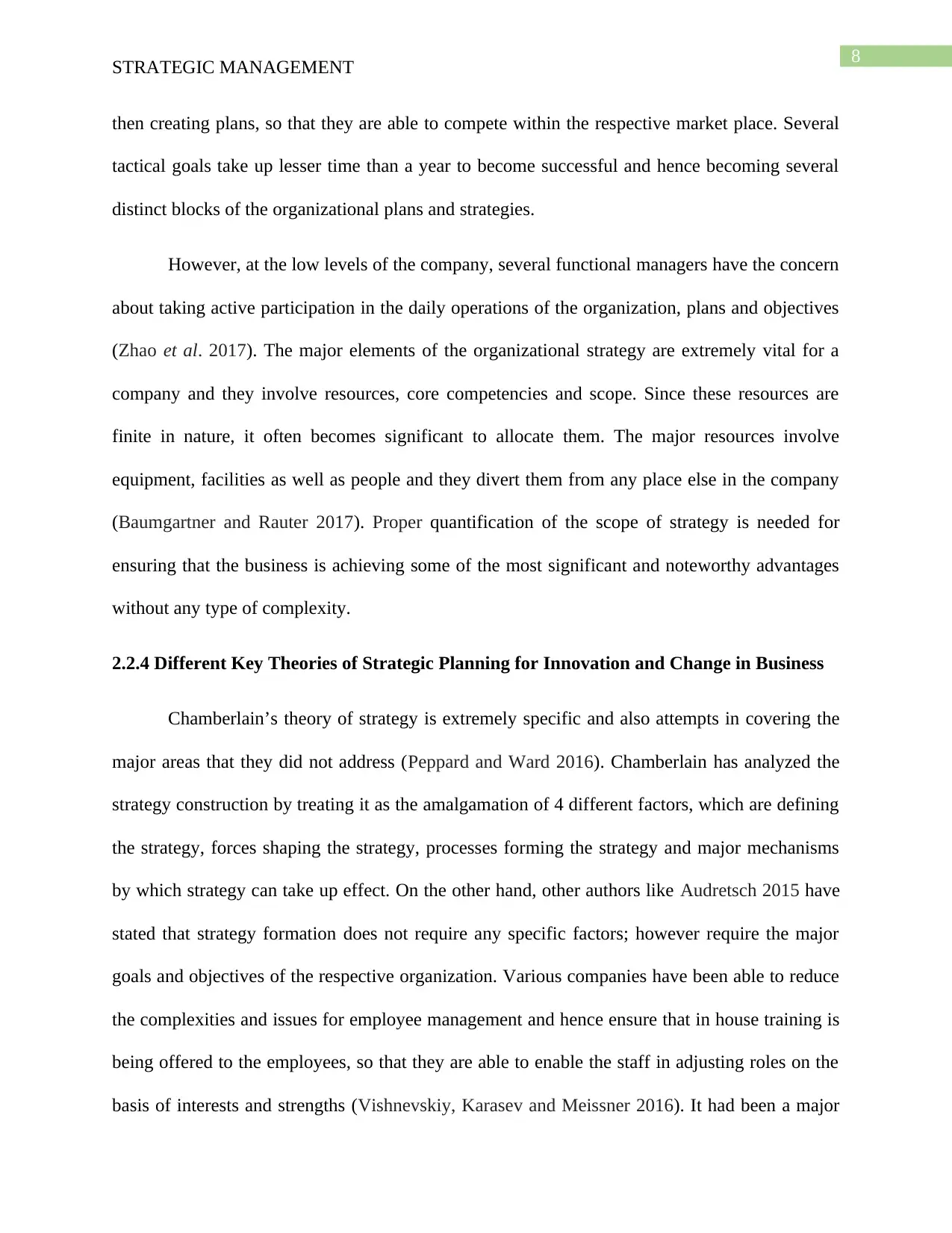
8
STRATEGIC MANAGEMENT
then creating plans, so that they are able to compete within the respective market place. Several
tactical goals take up lesser time than a year to become successful and hence becoming several
distinct blocks of the organizational plans and strategies.
However, at the low levels of the company, several functional managers have the concern
about taking active participation in the daily operations of the organization, plans and objectives
(Zhao et al. 2017). The major elements of the organizational strategy are extremely vital for a
company and they involve resources, core competencies and scope. Since these resources are
finite in nature, it often becomes significant to allocate them. The major resources involve
equipment, facilities as well as people and they divert them from any place else in the company
(Baumgartner and Rauter 2017). Proper quantification of the scope of strategy is needed for
ensuring that the business is achieving some of the most significant and noteworthy advantages
without any type of complexity.
2.2.4 Different Key Theories of Strategic Planning for Innovation and Change in Business
Chamberlain’s theory of strategy is extremely specific and also attempts in covering the
major areas that they did not address (Peppard and Ward 2016). Chamberlain has analyzed the
strategy construction by treating it as the amalgamation of 4 different factors, which are defining
the strategy, forces shaping the strategy, processes forming the strategy and major mechanisms
by which strategy can take up effect. On the other hand, other authors like Audretsch 2015 have
stated that strategy formation does not require any specific factors; however require the major
goals and objectives of the respective organization. Various companies have been able to reduce
the complexities and issues for employee management and hence ensure that in house training is
being offered to the employees, so that they are able to enable the staff in adjusting roles on the
basis of interests and strengths (Vishnevskiy, Karasev and Meissner 2016). It had been a major
STRATEGIC MANAGEMENT
then creating plans, so that they are able to compete within the respective market place. Several
tactical goals take up lesser time than a year to become successful and hence becoming several
distinct blocks of the organizational plans and strategies.
However, at the low levels of the company, several functional managers have the concern
about taking active participation in the daily operations of the organization, plans and objectives
(Zhao et al. 2017). The major elements of the organizational strategy are extremely vital for a
company and they involve resources, core competencies and scope. Since these resources are
finite in nature, it often becomes significant to allocate them. The major resources involve
equipment, facilities as well as people and they divert them from any place else in the company
(Baumgartner and Rauter 2017). Proper quantification of the scope of strategy is needed for
ensuring that the business is achieving some of the most significant and noteworthy advantages
without any type of complexity.
2.2.4 Different Key Theories of Strategic Planning for Innovation and Change in Business
Chamberlain’s theory of strategy is extremely specific and also attempts in covering the
major areas that they did not address (Peppard and Ward 2016). Chamberlain has analyzed the
strategy construction by treating it as the amalgamation of 4 different factors, which are defining
the strategy, forces shaping the strategy, processes forming the strategy and major mechanisms
by which strategy can take up effect. On the other hand, other authors like Audretsch 2015 have
stated that strategy formation does not require any specific factors; however require the major
goals and objectives of the respective organization. Various companies have been able to reduce
the complexities and issues for employee management and hence ensure that in house training is
being offered to the employees, so that they are able to enable the staff in adjusting roles on the
basis of interests and strengths (Vishnevskiy, Karasev and Meissner 2016). It had been a major
⊘ This is a preview!⊘
Do you want full access?
Subscribe today to unlock all pages.

Trusted by 1+ million students worldwide
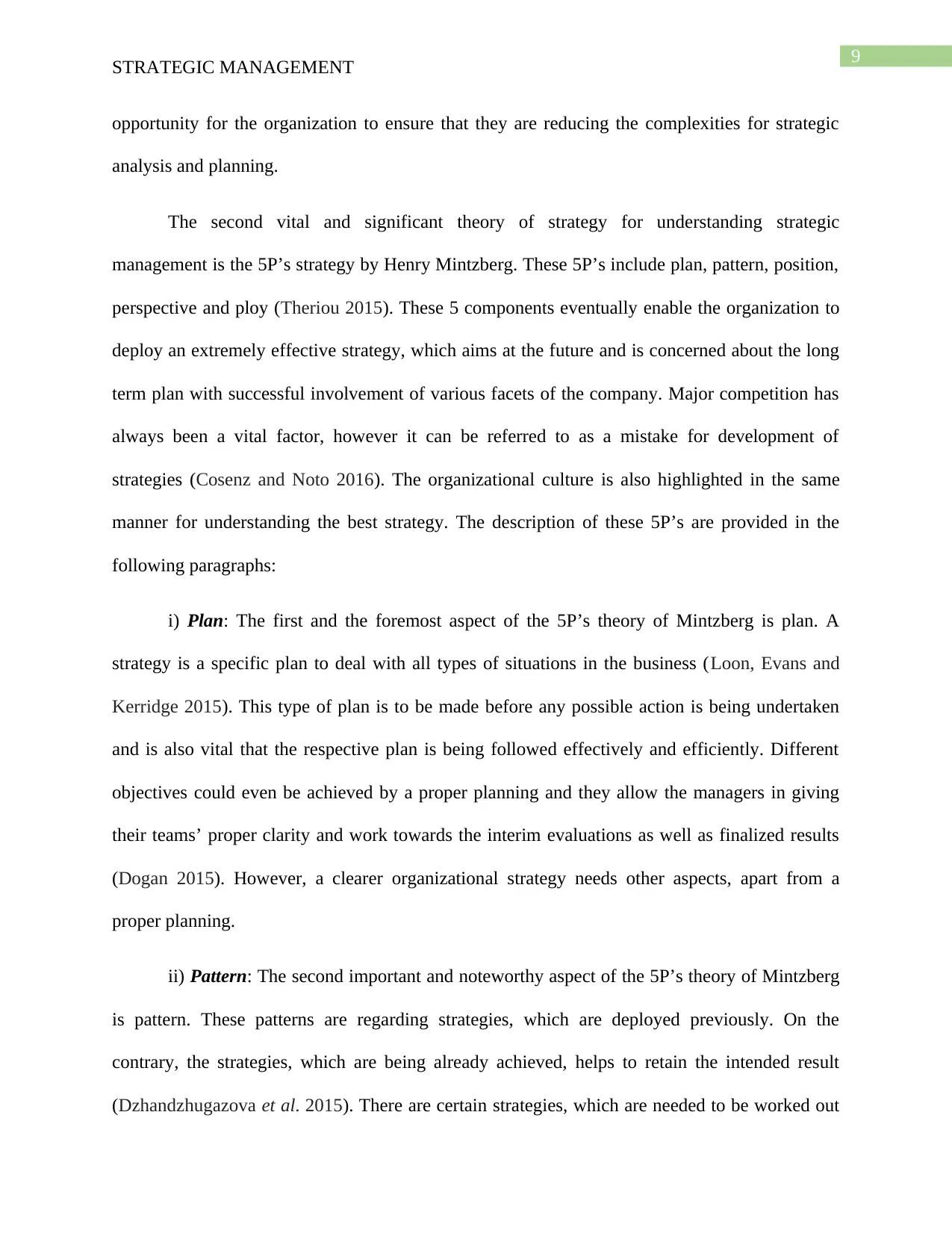
9
STRATEGIC MANAGEMENT
opportunity for the organization to ensure that they are reducing the complexities for strategic
analysis and planning.
The second vital and significant theory of strategy for understanding strategic
management is the 5P’s strategy by Henry Mintzberg. These 5P’s include plan, pattern, position,
perspective and ploy (Theriou 2015). These 5 components eventually enable the organization to
deploy an extremely effective strategy, which aims at the future and is concerned about the long
term plan with successful involvement of various facets of the company. Major competition has
always been a vital factor, however it can be referred to as a mistake for development of
strategies (Cosenz and Noto 2016). The organizational culture is also highlighted in the same
manner for understanding the best strategy. The description of these 5P’s are provided in the
following paragraphs:
i) Plan: The first and the foremost aspect of the 5P’s theory of Mintzberg is plan. A
strategy is a specific plan to deal with all types of situations in the business (Loon, Evans and
Kerridge 2015). This type of plan is to be made before any possible action is being undertaken
and is also vital that the respective plan is being followed effectively and efficiently. Different
objectives could even be achieved by a proper planning and they allow the managers in giving
their teams’ proper clarity and work towards the interim evaluations as well as finalized results
(Dogan 2015). However, a clearer organizational strategy needs other aspects, apart from a
proper planning.
ii) Pattern: The second important and noteworthy aspect of the 5P’s theory of Mintzberg
is pattern. These patterns are regarding strategies, which are deployed previously. On the
contrary, the strategies, which are being already achieved, helps to retain the intended result
(Dzhandzhugazova et al. 2015). There are certain strategies, which are needed to be worked out
STRATEGIC MANAGEMENT
opportunity for the organization to ensure that they are reducing the complexities for strategic
analysis and planning.
The second vital and significant theory of strategy for understanding strategic
management is the 5P’s strategy by Henry Mintzberg. These 5P’s include plan, pattern, position,
perspective and ploy (Theriou 2015). These 5 components eventually enable the organization to
deploy an extremely effective strategy, which aims at the future and is concerned about the long
term plan with successful involvement of various facets of the company. Major competition has
always been a vital factor, however it can be referred to as a mistake for development of
strategies (Cosenz and Noto 2016). The organizational culture is also highlighted in the same
manner for understanding the best strategy. The description of these 5P’s are provided in the
following paragraphs:
i) Plan: The first and the foremost aspect of the 5P’s theory of Mintzberg is plan. A
strategy is a specific plan to deal with all types of situations in the business (Loon, Evans and
Kerridge 2015). This type of plan is to be made before any possible action is being undertaken
and is also vital that the respective plan is being followed effectively and efficiently. Different
objectives could even be achieved by a proper planning and they allow the managers in giving
their teams’ proper clarity and work towards the interim evaluations as well as finalized results
(Dogan 2015). However, a clearer organizational strategy needs other aspects, apart from a
proper planning.
ii) Pattern: The second important and noteworthy aspect of the 5P’s theory of Mintzberg
is pattern. These patterns are regarding strategies, which are deployed previously. On the
contrary, the strategies, which are being already achieved, helps to retain the intended result
(Dzhandzhugazova et al. 2015). There are certain strategies, which are needed to be worked out
Paraphrase This Document
Need a fresh take? Get an instant paraphrase of this document with our AI Paraphraser
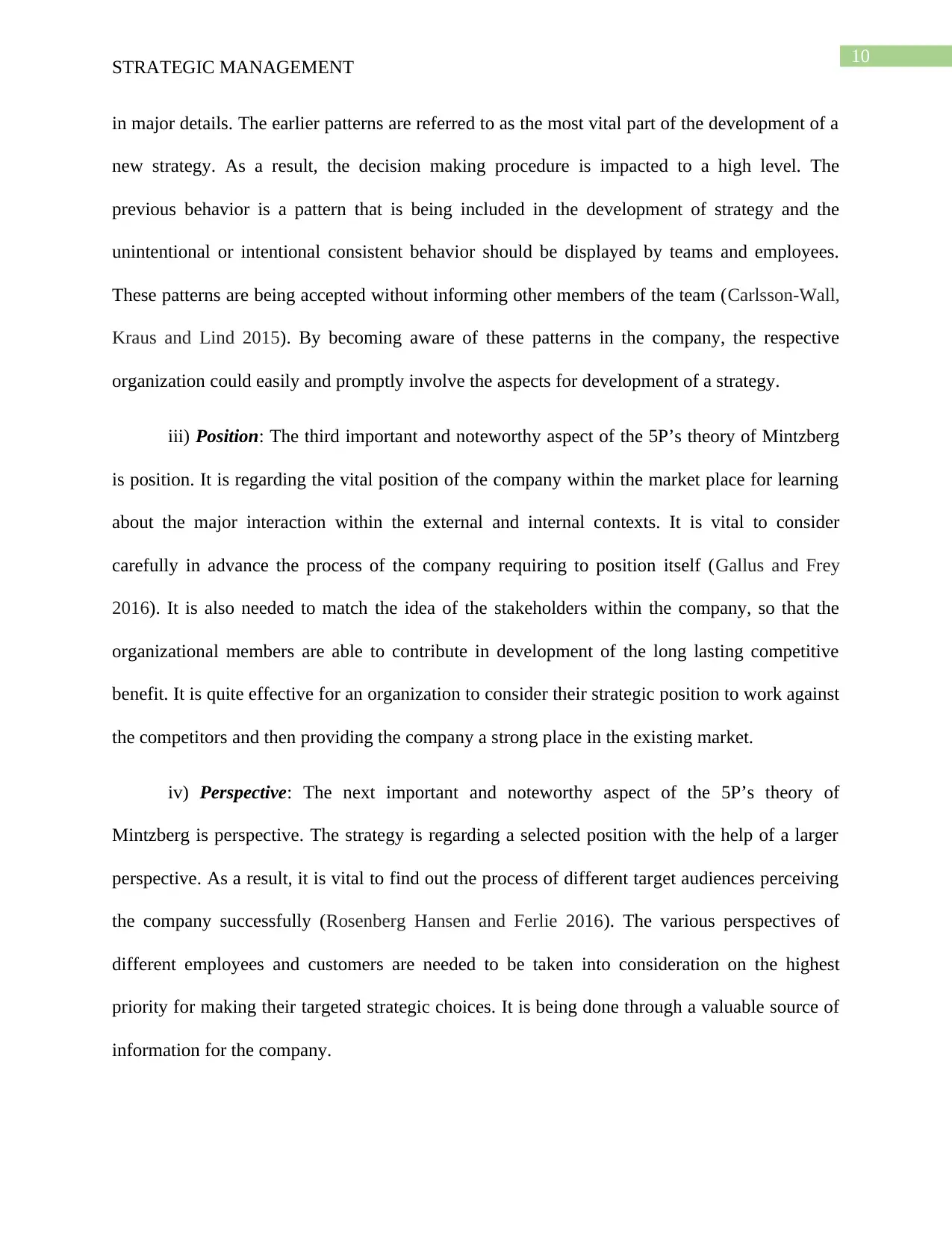
10
STRATEGIC MANAGEMENT
in major details. The earlier patterns are referred to as the most vital part of the development of a
new strategy. As a result, the decision making procedure is impacted to a high level. The
previous behavior is a pattern that is being included in the development of strategy and the
unintentional or intentional consistent behavior should be displayed by teams and employees.
These patterns are being accepted without informing other members of the team (Carlsson-Wall,
Kraus and Lind 2015). By becoming aware of these patterns in the company, the respective
organization could easily and promptly involve the aspects for development of a strategy.
iii) Position: The third important and noteworthy aspect of the 5P’s theory of Mintzberg
is position. It is regarding the vital position of the company within the market place for learning
about the major interaction within the external and internal contexts. It is vital to consider
carefully in advance the process of the company requiring to position itself (Gallus and Frey
2016). It is also needed to match the idea of the stakeholders within the company, so that the
organizational members are able to contribute in development of the long lasting competitive
benefit. It is quite effective for an organization to consider their strategic position to work against
the competitors and then providing the company a strong place in the existing market.
iv) Perspective: The next important and noteworthy aspect of the 5P’s theory of
Mintzberg is perspective. The strategy is regarding a selected position with the help of a larger
perspective. As a result, it is vital to find out the process of different target audiences perceiving
the company successfully (Rosenberg Hansen and Ferlie 2016). The various perspectives of
different employees and customers are needed to be taken into consideration on the highest
priority for making their targeted strategic choices. It is being done through a valuable source of
information for the company.
STRATEGIC MANAGEMENT
in major details. The earlier patterns are referred to as the most vital part of the development of a
new strategy. As a result, the decision making procedure is impacted to a high level. The
previous behavior is a pattern that is being included in the development of strategy and the
unintentional or intentional consistent behavior should be displayed by teams and employees.
These patterns are being accepted without informing other members of the team (Carlsson-Wall,
Kraus and Lind 2015). By becoming aware of these patterns in the company, the respective
organization could easily and promptly involve the aspects for development of a strategy.
iii) Position: The third important and noteworthy aspect of the 5P’s theory of Mintzberg
is position. It is regarding the vital position of the company within the market place for learning
about the major interaction within the external and internal contexts. It is vital to consider
carefully in advance the process of the company requiring to position itself (Gallus and Frey
2016). It is also needed to match the idea of the stakeholders within the company, so that the
organizational members are able to contribute in development of the long lasting competitive
benefit. It is quite effective for an organization to consider their strategic position to work against
the competitors and then providing the company a strong place in the existing market.
iv) Perspective: The next important and noteworthy aspect of the 5P’s theory of
Mintzberg is perspective. The strategy is regarding a selected position with the help of a larger
perspective. As a result, it is vital to find out the process of different target audiences perceiving
the company successfully (Rosenberg Hansen and Ferlie 2016). The various perspectives of
different employees and customers are needed to be taken into consideration on the highest
priority for making their targeted strategic choices. It is being done through a valuable source of
information for the company.
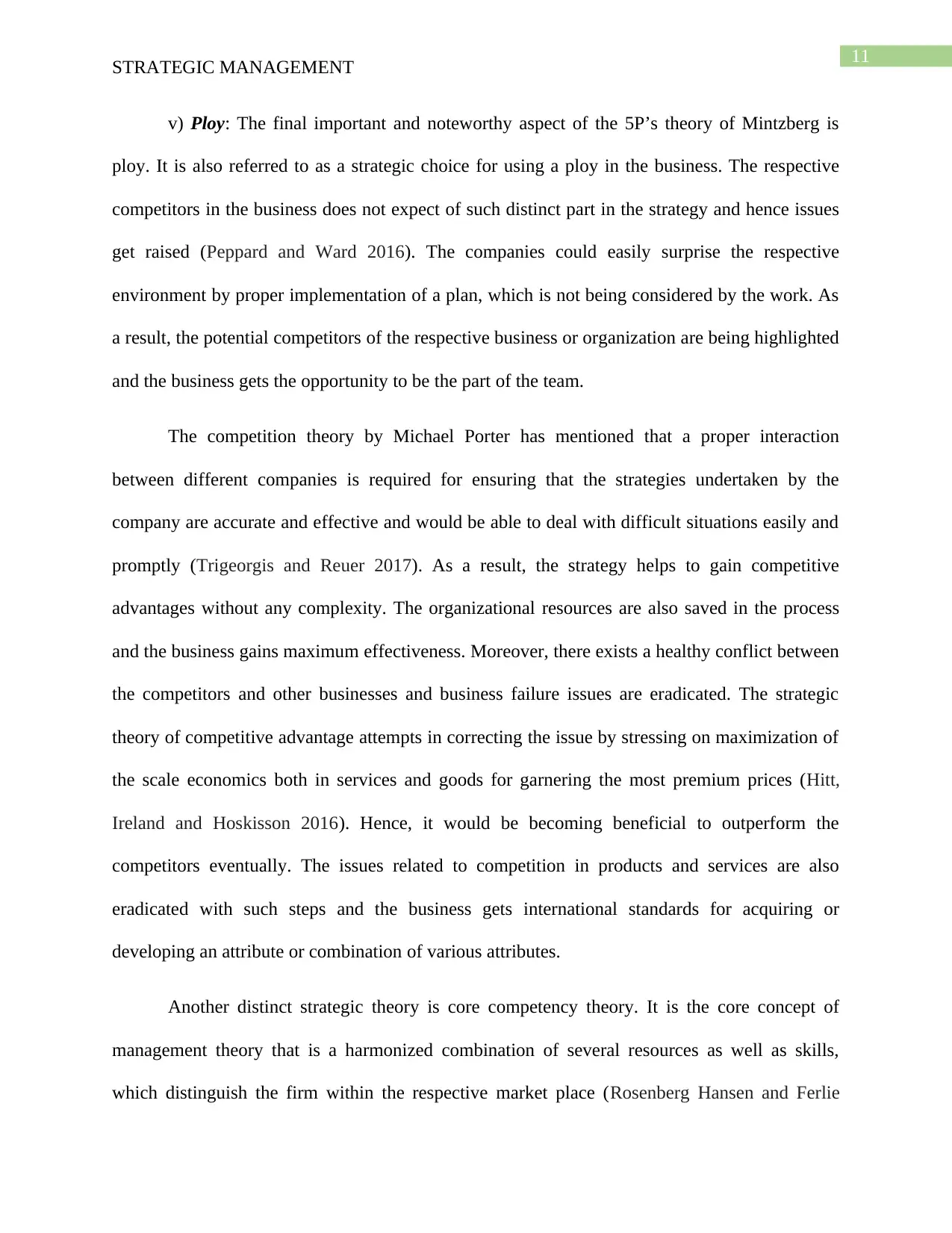
11
STRATEGIC MANAGEMENT
v) Ploy: The final important and noteworthy aspect of the 5P’s theory of Mintzberg is
ploy. It is also referred to as a strategic choice for using a ploy in the business. The respective
competitors in the business does not expect of such distinct part in the strategy and hence issues
get raised (Peppard and Ward 2016). The companies could easily surprise the respective
environment by proper implementation of a plan, which is not being considered by the work. As
a result, the potential competitors of the respective business or organization are being highlighted
and the business gets the opportunity to be the part of the team.
The competition theory by Michael Porter has mentioned that a proper interaction
between different companies is required for ensuring that the strategies undertaken by the
company are accurate and effective and would be able to deal with difficult situations easily and
promptly (Trigeorgis and Reuer 2017). As a result, the strategy helps to gain competitive
advantages without any complexity. The organizational resources are also saved in the process
and the business gains maximum effectiveness. Moreover, there exists a healthy conflict between
the competitors and other businesses and business failure issues are eradicated. The strategic
theory of competitive advantage attempts in correcting the issue by stressing on maximization of
the scale economics both in services and goods for garnering the most premium prices (Hitt,
Ireland and Hoskisson 2016). Hence, it would be becoming beneficial to outperform the
competitors eventually. The issues related to competition in products and services are also
eradicated with such steps and the business gets international standards for acquiring or
developing an attribute or combination of various attributes.
Another distinct strategic theory is core competency theory. It is the core concept of
management theory that is a harmonized combination of several resources as well as skills,
which distinguish the firm within the respective market place (Rosenberg Hansen and Ferlie
STRATEGIC MANAGEMENT
v) Ploy: The final important and noteworthy aspect of the 5P’s theory of Mintzberg is
ploy. It is also referred to as a strategic choice for using a ploy in the business. The respective
competitors in the business does not expect of such distinct part in the strategy and hence issues
get raised (Peppard and Ward 2016). The companies could easily surprise the respective
environment by proper implementation of a plan, which is not being considered by the work. As
a result, the potential competitors of the respective business or organization are being highlighted
and the business gets the opportunity to be the part of the team.
The competition theory by Michael Porter has mentioned that a proper interaction
between different companies is required for ensuring that the strategies undertaken by the
company are accurate and effective and would be able to deal with difficult situations easily and
promptly (Trigeorgis and Reuer 2017). As a result, the strategy helps to gain competitive
advantages without any complexity. The organizational resources are also saved in the process
and the business gains maximum effectiveness. Moreover, there exists a healthy conflict between
the competitors and other businesses and business failure issues are eradicated. The strategic
theory of competitive advantage attempts in correcting the issue by stressing on maximization of
the scale economics both in services and goods for garnering the most premium prices (Hitt,
Ireland and Hoskisson 2016). Hence, it would be becoming beneficial to outperform the
competitors eventually. The issues related to competition in products and services are also
eradicated with such steps and the business gets international standards for acquiring or
developing an attribute or combination of various attributes.
Another distinct strategic theory is core competency theory. It is the core concept of
management theory that is a harmonized combination of several resources as well as skills,
which distinguish the firm within the respective market place (Rosenberg Hansen and Ferlie
⊘ This is a preview!⊘
Do you want full access?
Subscribe today to unlock all pages.

Trusted by 1+ million students worldwide
1 out of 29
Related Documents
Your All-in-One AI-Powered Toolkit for Academic Success.
+13062052269
info@desklib.com
Available 24*7 on WhatsApp / Email
![[object Object]](/_next/static/media/star-bottom.7253800d.svg)
Unlock your academic potential
Copyright © 2020–2025 A2Z Services. All Rights Reserved. Developed and managed by ZUCOL.





